#176: The Genus Lactarius
Lactarius species are among the most easily-recognized mushrooms. Often called “Milk Caps” (the ‘lact-’ part of the genus name refers to ‘milk’), these distinctive mushrooms release a watery latex when injured. Lactarius mushrooms look a lot like russulas (FFF#175), which are very close relatives.
Description
The most notable feature of Lactarius mushrooms is that they exude a milky substance called ‘milk’ or ‘latex’ when injured. This latex is often white, but can be red to yellow to brown or even blue! Lactarius mushrooms store their latex in special cells called ‘lactiferous tubes’ or ‘lactifers.’1–3 Supposedly, this latex is beneficial to the mushroom because it clogs up the mouthparts of insects and other tiny animals that bite the mushroom. Indeed, slugs (which are often seen chowing down on russulas) leave Lactarii alone for the most part.
Mushrooms produce different amounts of latex based on species, environmental conditions, and age.1 L. volemus is one of the best latex producers in the genus.4 The slightest injury to that mushroom causes large milky drops to well up on the surface and drip to the ground. On the other end of the spectrum, there are mushrooms like L. indigo (FFF#052), which produce only enough latex to make the injured area tacky.3 The amount of latex produced also decreases if the weather is dry and if the mushroom is an older specimen.1
There are several other species of agarics that exude liquid when injured, but Lactarius is easily separated from these thanks to its crumbly flesh. Just like Russula species, Lactarius mushrooms are composed of globular cells called sphaerocysts. Most mushrooms use cylindrical hyphae for structure, which makes the mushrooms stringy and fibrous. The rounded cells of Russula and Lactarius, however, make the mushrooms brittle and crumbly. Even though Lactarii are generally firmer than russulas, this feature is still distinctive enough to easily separate Lactarii from other agarics that exude liquids.1–3
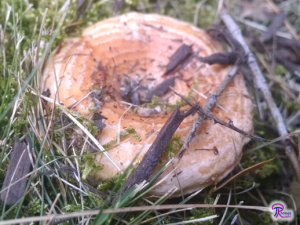
Lactarius mushrooms are often zonate and have a depressed pileus. Like russulas, they are usually short and squat.
Lactarius mushrooms also resemble russulas in shape. Like their relatives, Lactarii are usually medium-sized to large mushrooms with a stipe that is almost never longer than the pileus is wide. However, Lactarius species more frequently have zonate caps and are more likely to be depressed to nearly funnel-shaped in the center of the pileus. Additionally, the pileus margin flares upward more often in Lactarius species. The milk mushrooms also sometimes have small, pothole-like depressions on the surface of their stipe or pileus called ‘scrobiculi’ that never occur in their sister genus. Russula species usually have a more colorful pileus and more contrast between the pileus and gills than their relatives in Lactarius. Of course, there is a lot of morphological overlap between the two genera. The only way to accurately differentiate between Russula and Lactarius is to check for the presence of latex.1,2
Both Lactarius and Russula are ectomycorrhizal fungi, so they are usually found growing on the ground close to trees.1,2 In temperate climates, Lactarius mushrooms normally appear from late spring through autumn, often at the same times and in similar habitats as russulas.
Edibility
Lactarius contains edible, inedible, and poisonous species. The most popular edible milk mushrooms are L. volemus and the Candy Caps (FFF#123). L. volemus is eaten like a normal mushroom, while the Candy Caps have a strong maple syrup flavor and are usually used in desserts. As with the russulas, the crumbly texture of Lactarius mushrooms is a bit off-putting. For this reason, most people ignore all other edible Lactarius species.5
Many other Lactarius mushrooms are considered inedible because of their extremely acrid taste. Even a small bite of L. deceptivus leaves an unpleasant burning sensation in your mouth for a long time. Although some of the acrid Lactarii are not poisonous, nobody would enjoy eating them.5
As with the russulas, poisonous species of Lactarius primarily cause gastrointestinal distress.5 You shouldn’t go experimenting with Lactarius, but the good edibles should be easy enough to identify with a decent field guide and some experience in Lactarius identification.
Identifying Lactarii to Species
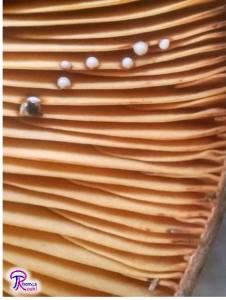
Latex color is very important for Lactarius identification. This latex is white and slowly dries brown.
Identifying a Lactarius mushroom down to species is an easier task than doing so for a Russula. That being said, there are a lot of Lactarius species in North America and mycologists are still adding to that number by using DNA to find cryptic species. A good field guide should help you key out the most interesting species. If you’re still stuck, try using this 1979 book on North American Lactarii (be warned: it’s rather difficult to use): North American Species of Lactarius
Latex is very important in Lactarius identification. If you are going to attempt to identify a milk mushroom, you need to note everything that happens to the latex. What color is it when it is first exposed? What color is it after ten minutes? After an hour? What color does it stain the gills? Many species have latex that starts out one color and doesn’t change until over an hour of exposure to air. Others change rapidly and some don’t change at all. A good way to check for latex color and any changes is to smear some of the latex on a white piece of paper. This makes any colors other than white immediately visible. Of course, latex alone won’t get you to an answer. Make a note of the mushroom’s other morphological features as well as its habitat and the nearby trees.
Taxonomy
Thanks to new DNA studies, the genus Lactarius is changing. Mycologists seem to be in the process of moving a large chunk of the fungi to the genus Lactifluus. So far, the only major website to incorporate this change is Wikipedia. However, the name Lactifluus is already being thrown around in mushroom clubs and is in use on the Champignons du Quebéc site (for example, this page on Lactifluus/ Lactarius voleumus). Mycobank, on the other hand, lists Lactarius volemus as the current name for that mushroom but recognizes both that and Lactifluus volemus as valid names.6,7 Wikipedia lists one more genus in the Russula/ Lactarius group: Multifurca. Apparently, those mushrooms have features of both russulas and Lactarii.8
My descriptions of Lactarius on this page apply to all latex-producing species in the Russulaceae. I decided to stick with the name Lactarius for most of this post because the taxonomy of Lactarius and related species is still in flux and because most field guides don’t even mention Lactifluus. Perhaps I will rename this page “Lactarioid Mushrooms” once the group’s taxonomy is settled.
| Kingdom | Fungi |
| Phylum | Basidiomycota |
| Subphylum | Agaricomycotina |
| Class | Agaricomycetes |
| Order | Russulales |
| Family | Russulaceae |
| Genus | Lactarius Pers.9
Lactifluus (Pers.) Roussel10 |
* Mycobank did not give a family for Multifurca, but it is very closely related to Russula and Lactarius, so it will probably end up in the Russulaceae.12,13
This post describes a group of mushrooms and as such the information on this page (including the pictures) cannot be used to identify any mushroom in particular.
This post does not contain enough information to positively identify any mushroom. When collecting for the table, always use a local field guide to identify your mushrooms down to species. If you need a quality, free field guide to North American mushrooms, I recommend Michael Kuo’s MushroomExpert.com. Remember: when in doubt, throw it out!
See Further:
http://www.mushroomexpert.com/lactarius.html
http://www.svims.ca/council/Lactar.htm
http://botit.botany.wisc.edu/toms_fungi/june2000.html
http://quod.lib.umich.edu/f/fung1tc/aac3719.0001.001/1?view=image&size=100
Citations
- Michael Kuo. The Genus Lactarius. MushroomExpert.Com (2011). Available at: http://www.mushroomexpert.com/lactarius.html. (Accessed: 3rd February 2017)
- Coleman S. Leuthy. Key to species of LACTARIUS in the Pacific Northwest. Pacific Northwest Key Council (1997). Available at: http://www.svims.ca/council/Lactar.htm. (Accessed: 3rd February 2017)
- Thomas J. Volk. Tom Volk’s Fungus of the Month for June 2000. Tom Volk’s Fungi (2000). Available at: http://botit.botany.wisc.edu/toms_fungi/june2000.html. (Accessed: 3rd February 2017)
- Michael Kuo. Lactarius volemus. MushroomExpert.Com (2011). Available at: http://www.mushroomexpert.com/lactarius_volemus.html. (Accessed: 3rd February 2017)
- Miller, O. K. & Miller, H. North American mushrooms: a field guide to edible and inedible fungi. (Falcon Guide, 2006).
- Lactarius volemus. Mycobank Available at: http://www.mycobank.org/BioloMICS.aspx?TableKey=14682616000000067&Rec=116292&Fields=All. (Accessed: 3rd February 2017)
- Lactifluus volemus. Mycobank Available at: http://www.mycobank.org/BioloMICS.aspx?Table=Mycobank&Rec=411118&Fields=All. (Accessed: 3rd February 2017)
- Multifurca. Wikipedia (2016).
- Lactarius. Mycobank Available at: http://www.mycobank.org/BioloMICS.aspx?TableKey=14682616000000067&Rec=56791&Fields=All. (Accessed: 3rd February 2017)
- Lactifluus. Mycobank Available at: http://www.mycobank.org/BioloMICS.aspx?Table=Mycobank&Rec=101092&Fields=All. (Accessed: 3rd February 2017)
- Multifurca. Mycobank Available at: http://www.mycobank.org/BioloMICS.aspx?Table=Mycobank&Rec=442915&Fields=All. (Accessed: 3rd February 2017)
- Lactifluus. Wikipedia (2016).
- B. Buyck, V. Hofstetter, U. Eberhardt, A. Verbeken & F. Kauff. Walking the thin line between Russula and Lactarius : the dilemma of Russula subsect. Ochricompactae. Fungal Diversity 28, 15–40 (2008).

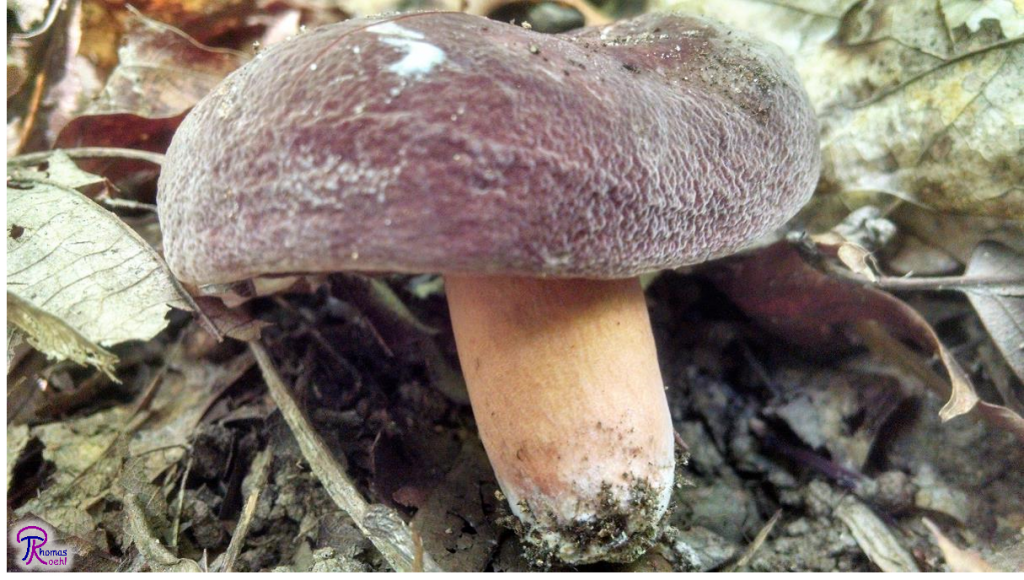






![#011: Characteristics of Kingdom Fungi [Archived]](https://www.fungusfactfriday.com/wp-content/themes/hueman/assets/front/img/thumb-small-empty.png)

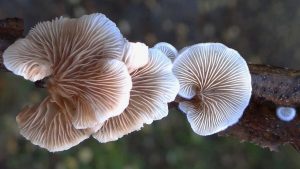
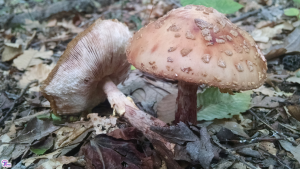
2 Responses
[…] flesh should easily break apart into small, crumb-like pieces. Mushrooms in the genus Lactarius (FFF#176) also have sphaerocysts, but Lactarius mushrooms exude liquid when […]
[…] Lactarius14-16 […]